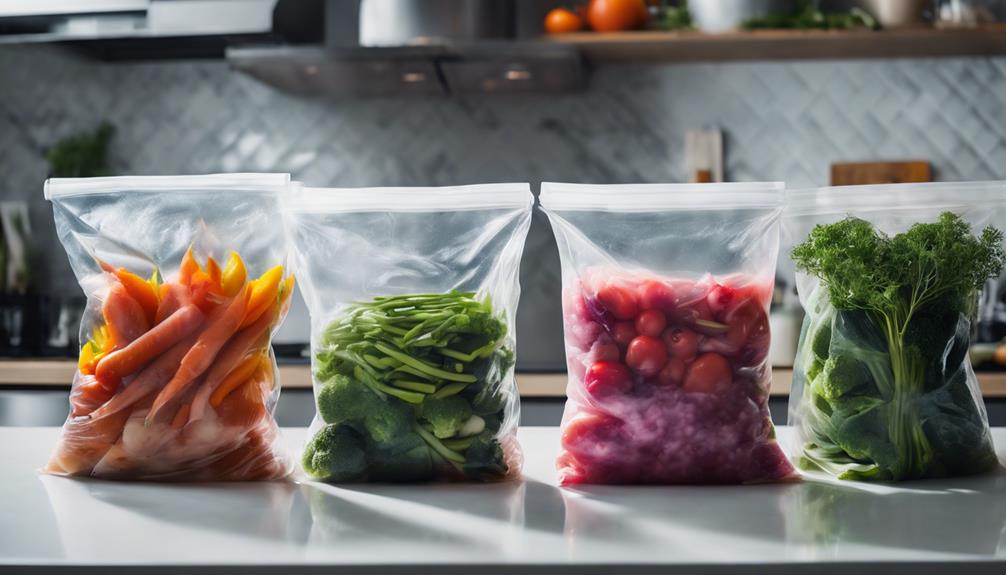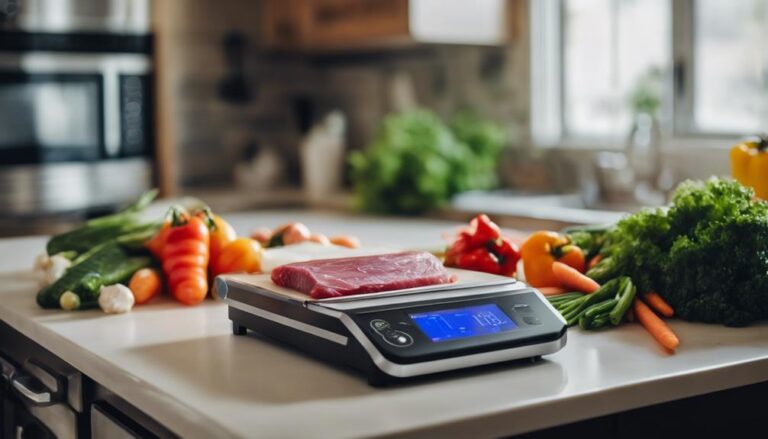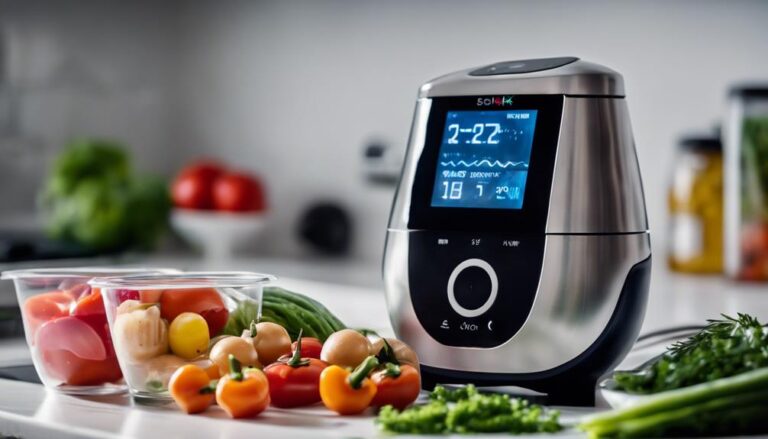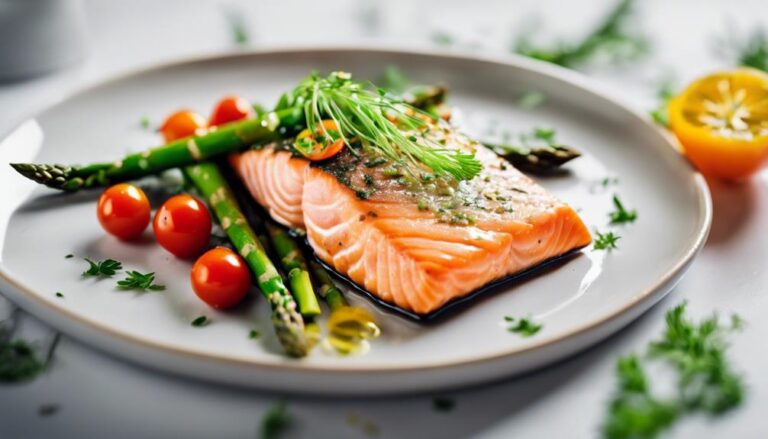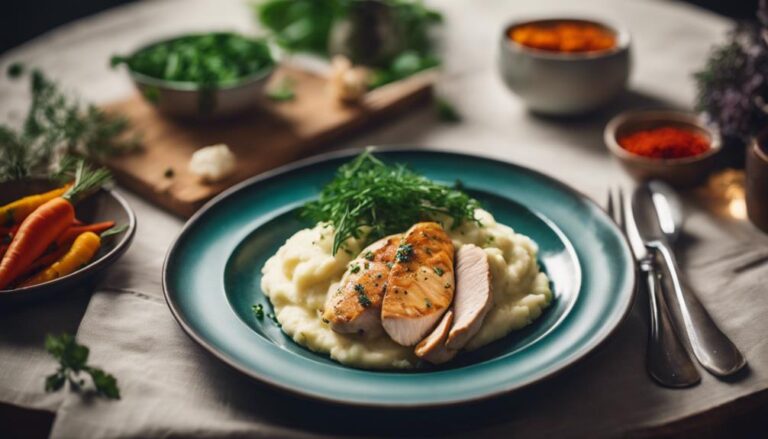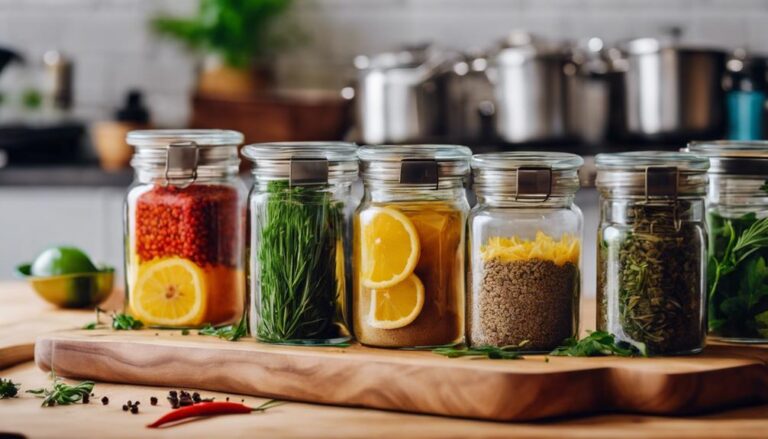How to Sous Vide Healthy Frozen Meals
To sous vide healthy frozen meals, start by vacuum-sealing your ingredients, preventing freezer burn and locking in flavors. You can skip defrosting; just extend cooking times by 50% for frozen items to guarantee food cooks thoroughly. For example, a frozen steak at 130°F needs about three hours. Use fresh herbs and spices before sealing for better taste. Store vacuum-sealed bags in the freezer for up to six weeks. When ready to cook, set the water bath to your desired doneness. This method not only preserves nutrients but also maintains a high-quality meal. There's plenty more to explore on meal prep techniques.
What You Will Learn Here
- Use a high-quality vacuum sealer to package proteins and vegetables airtight, preventing freezer burn and preserving flavor.
- Cook frozen meals by extending the cooking time by 50% for thorough heating and safety.
- Marinate proteins before vacuum sealing to enhance flavor, and pair with fresh, seasonal vegetables.
- Store vacuum-sealed meals in the freezer for up to six weeks to maintain peak quality.
Benefits of Frozen Sous Vide
One of the biggest benefits of cooking frozen meals sous vide is that you can skip defrosting and still enjoy perfectly cooked dishes anytime.
With sous vide cooking, you can take advantage of frozen food without compromising on quality. The vacuum-sealed packaging not only prevents freezer burn but also locks in flavors, ensuring your meals taste just as intended, even after storage.
This method allows for precise temperature control, which is essential when cooking proteins like chicken, fish, and pork. You'll achieve tender, juicy results, whether you start with fresh or frozen ingredients.
Furthermore, when you're preparing meals in advance, you can easily extend cooking times by about 50% for frozen items, ensuring they're thoroughly cooked while retaining their nutritional value.
Tips for Meal Prep Success
To make the most of your frozen sous vide meals, effective meal prep strategies can set you up for success. Start by investing in a high-quality vacuum sealer. This will help you package your meals airtight, preventing freezer burn and preserving flavor. Don't forget to label and date your bags; it makes tracking freshness easy.
Aim for variety in your sous vide meal prep. Batch-prepping different proteins and vegetables keeps meals balanced and exciting. When it comes to the seasoning process, use fresh herbs and spices before vacuum sealing. This enhances the flavor and nutrition of your dishes.
Here's a quick guide to help you plan:
| Prep Step | Details |
|---|---|
| Invest in Equipment | High-quality vacuum sealer |
| Label & Date | Track meal freshness |
| Aim for Variety | Different proteins & veggies |
| Adjust Cooking Time | Extend cooking time by 50% |
Cooking Times for Frozen Foods
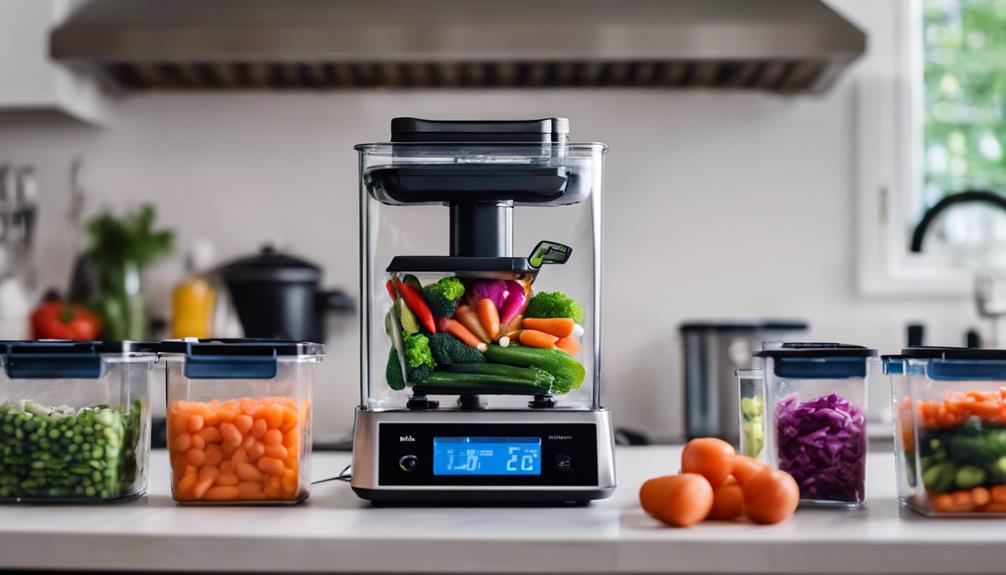
When cooking frozen foods sous vide, you'll need to extend the cooking time by about 50% to confirm everything is thoroughly heated and safe to eat.
For instance, if a fresh steak at 130°F normally takes 2 hours, a frozen steak will require approximately 3 hours to be perfectly cooked. This is vital, especially when you're meal planning for family or friends.
Keep in mind that cooking times can also vary based on the thickness of the food. Thicker items generally require longer cooking durations, so be sure to factor that in when planning your meals.
A quick reference for reheating frozen pre-cooked meals is to add around 30 minutes to the original cooking time to make certain they reach the appropriate core temperature.
Using a sous vide immersion circulator equipped with a cooking from frozen option, like the Joule app, can simplify the process greatly. It provides accurate cooking times for different frozen foods, making sure your meals come out just right.
Starting With Frozen Fish
Starting with frozen fish, like salmon filets, provides a quick and nutritious meal option that simplifies your cooking process. You can cook frozen fish directly from the freezer without defrosting, saving you time and effort.
When sous vide cooking frozen fish, set your water temperature to around 130°F (54°C) and cook for about three hours. This is roughly 50% longer than fresh fish but guarantees perfect results.
To enhance flavor while preventing freezer burn, consider vacuum-sealing the fish with olive oil, lemon, and your favorite seasonings. This method not only preserves the fish but also adds a gourmet touch to your meal.
Pair your sous vide fish with vacuum-sealed frozen vegetables to create a balanced meal that cooks simultaneously in the same water bath, maximizing efficiency.
Using sous vide for frozen fish assures consistent cooking, making certain your dish retains its moisture and texture. Every time you serve this meal option, your guests will enjoy perfectly cooked fish that's both healthy and flavorful.
With just a little planning, you can impress others with minimal effort while enjoying the benefits of sous vide cooking.
Preparing Meals for Later
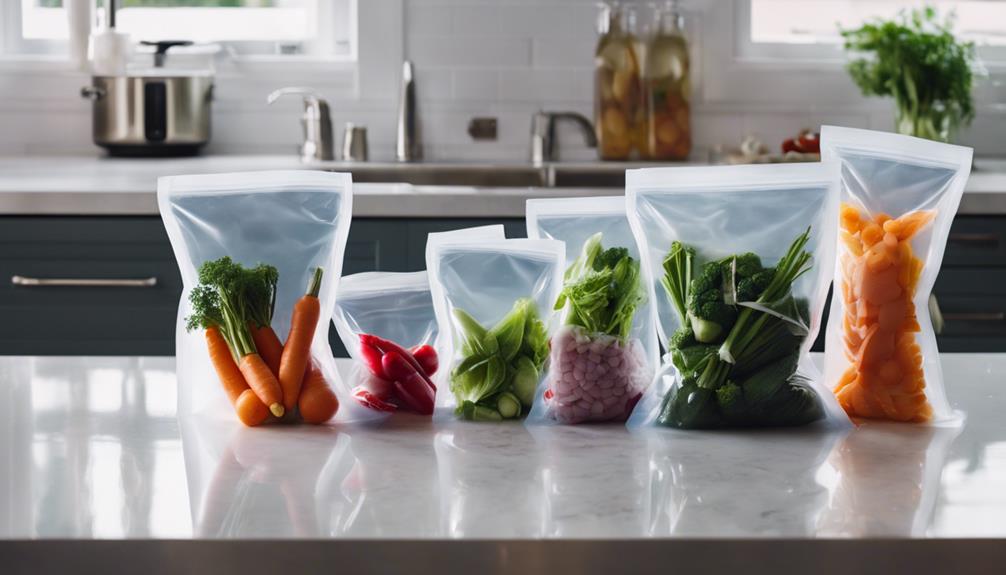
Preparing meals for later allows you to enjoy delicious, home-cooked dishes with minimal effort during busy days. Start your meal prep by batch-cooking proteins and vegetables, using fresh ingredients to enhance flavor and nutritional value.
A vacuum-sealer is your best friend here; it helps preserve the quality of your meals while preventing freezer burn. When sealing, consider marinating your sous vide chicken beforehand. This not only infuses flavor but also solidifies the marinade in the freezer, enhancing the taste when you cook it later.
As you prepare meals, remember to label and date each vacuum-sealed bag. This practice helps you track freshness and guarantees you use the meals within the recommended six-week freezing period.
Adjusting your cook time is essential when reheating frozen meals; extend it by 50% to assure thorough cooking and safety. By following these steps, you'll create a convenient and enjoyable dining experience for yourself and your loved ones.
With a little planning and the right cooking methods, you'll have an array of tasty, healthy meals ready to serve at a moment's notice.
Cooking Techniques and Methods
Sous vide cooking from frozen requires careful attention to timing and temperature to confirm your meals turn out perfectly every time.
When using a vacuum sealer to prepare chicken breasts or tough cuts of meat, remember to extend the cooking time by approximately 30 minutes for every inch of thickness. This confirms even cooking throughout the protein.
Set your temperature-controlled water bath to the desired doneness; for instance, cooking beef at 134°F yields a medium-rare result, maintaining tenderness even when cooked from frozen.
If you're cooking vegetables alongside your meat, start with the vegetables at a higher temperature, around 185°F, then reset the bath for the meat. This method confirms both components are cooked to perfection without overcooking.
After cooking, utilize the quick chill method by submerging the vacuum-sealed bags in an ice water bath for 30-45 minutes before freezing. This process helps maintain the quality and flavor of your meals.
Marinating and Vegetable Preparation
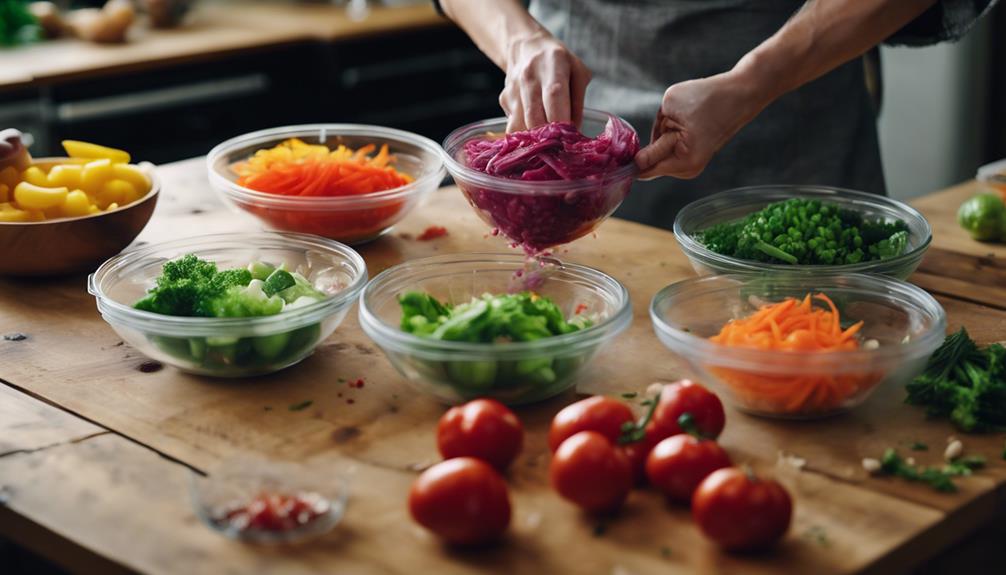
Marinating proteins before freezing not only enhances their flavor but also guarantees a delicious meal when you sous vide them later. By vacuum-sealing your proteins with a marinade, you allow the flavors to infuse deeply into the meat, ensuring a satisfying dish when cooked.
When preparing vegetables, choose fresh, seasonal options. After washing and prepping them, season lightly to boost their flavor during cooking. Vacuum-sealing vegetables preserves their freshness and nutrients, making your meals healthier and tastier.
Here's a simple guide for marinating and preparing your ingredients:
| Protein Type | Recommended Marinade | Ideal Vegetables |
|---|---|---|
| Chicken | Lemon herb | Asparagus |
| Beef | Soy sauce and ginger | Bell peppers |
| Pork | BBQ sauce | Zucchini |
| Fish | Olive oil and garlic | Broccoli |
| Tofu | Teriyaki sauce | Carrots |
Storage and Vacuum Sealing
After marinating and prepping your ingredients, proper storage and vacuum sealing are key to preserving their quality until you're ready to cook.
Invest in a reliable vacuum sealer for airtight packaging, which prevents freezer burn and maintains the flavor and nutritional quality of your meals. By using vacuum-sealed bags, you can store your meals in the freezer for up to six weeks, guaranteeing peak quality.
When sealing, remember to remove as much air as possible. This enhances the longevity of your food and promotes even cooking during the sous vide process. For best results, opt for sous vide bags that are specifically designed to withstand high temperatures, so they remain intact while cooking.
It's also important to label and date each vacuum-sealed bag. This helps you keep track of meal freshness and avoids confusion when selecting items from your freezer.
If you decide to refrigerate your vacuum-sealed meals, use them within 48 hours before cooking.
Following these storage and vacuum sealing tips will guarantee that you serve delicious, healthy meals that everyone will enjoy!
Money-Saving Purchasing Strategies
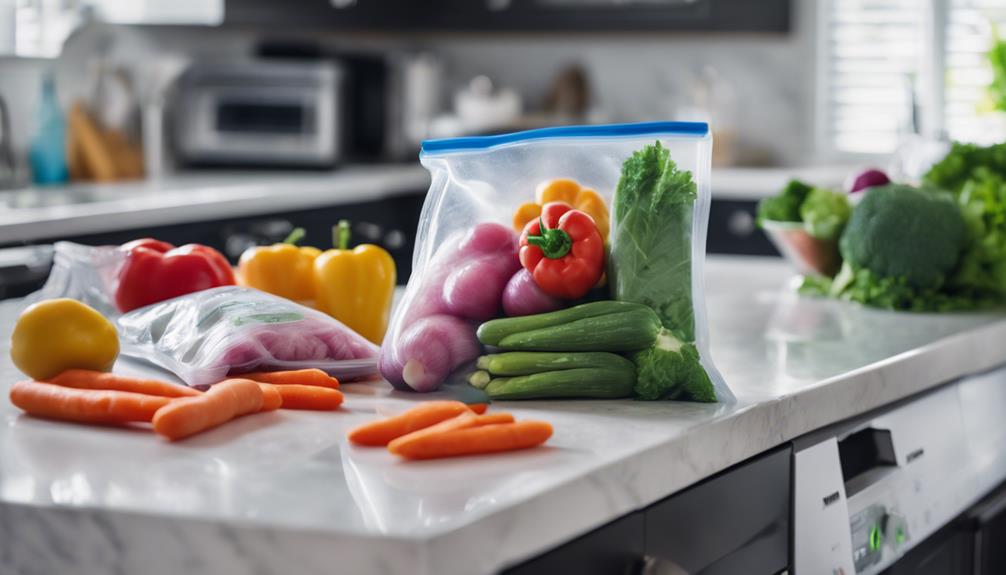
To stretch your budget while enjoying delicious meals, consider implementing strategic purchasing habits that focus on bulk buying and seasonal ingredients.
Buying family-sized packages of meat, poultry, and seafood allows you to take advantage of bulk pricing, considerably reducing your per-serving costs. Keep an eye on local grocery sales, as popular cuts of meat often serve as “loss leaders,” providing excellent savings during promotions.
Investing in a vacuum sealer is a smart move. It helps you portion and seal meats immediately, extending their shelf life and preventing freezer burn. This way, you save money on waste and guarantee you always have quality ingredients on hand.
Don't forget about seasonal vegetables. Purchasing these in-season items can be more cost-effective, as they tend to be fresher and cheaper.
Additionally, plan your meals around bulk purchases to maximize usage of frozen foods. Efficient meal prep strategies will help you minimize waste while guaranteeing you serve your loved ones tasty and nutritious meals.
With these money-saving purchasing strategies, you can enjoy home-cooked dishes without breaking the bank.
Frequently Asked Questions
Can You Sous Vide Frozen Meals?
Yes, you can sous vide frozen meals safely. By adjusting cooking times, you enhance flavor retention and texture improvement while preserving nutrients. This method also promotes portion control, making meal prep for others a breeze.
How Do You Make Frozen Meals Healthier?
You can make frozen meals healthier by focusing on ingredient quality, practicing portion control during meal prep, using nutritious cooking techniques, and enhancing flavor with seasoning options while ensuring a nutritional balance that serves others well.
Is Sous Vide the Healthiest Way to Cook?
Is sous vide the healthiest way to cook? Absolutely! It offers amazing benefits like nutrient retention, precise temperature control, and flavor enhancement, making your meal prep easier while ensuring portion control and healthier meals for those you serve.
Should You Freeze Before or After Sous Vide?
When deciding whether to freeze before or after sous vide, consider your goals. Freezing techniques affect flavor enhancement, texture preservation, and nutrient retention. Plan for sous vide timing to guarantee food safety and ideal meal prep.
Conclusion
Using sous vide to prepare healthy frozen meals offers convenience and consistency in cooking.
By following the tips outlined, you can efficiently meal prep and enjoy nutritious dishes anytime.
Remember to take into account cooking times and proper storage techniques, ensuring your meals retain their flavor and quality.
With a little planning, you can save time and money while enjoying delicious, home-cooked meals that fit your dietary needs.
Embrace the benefits of sous vide for a healthier lifestyle.
